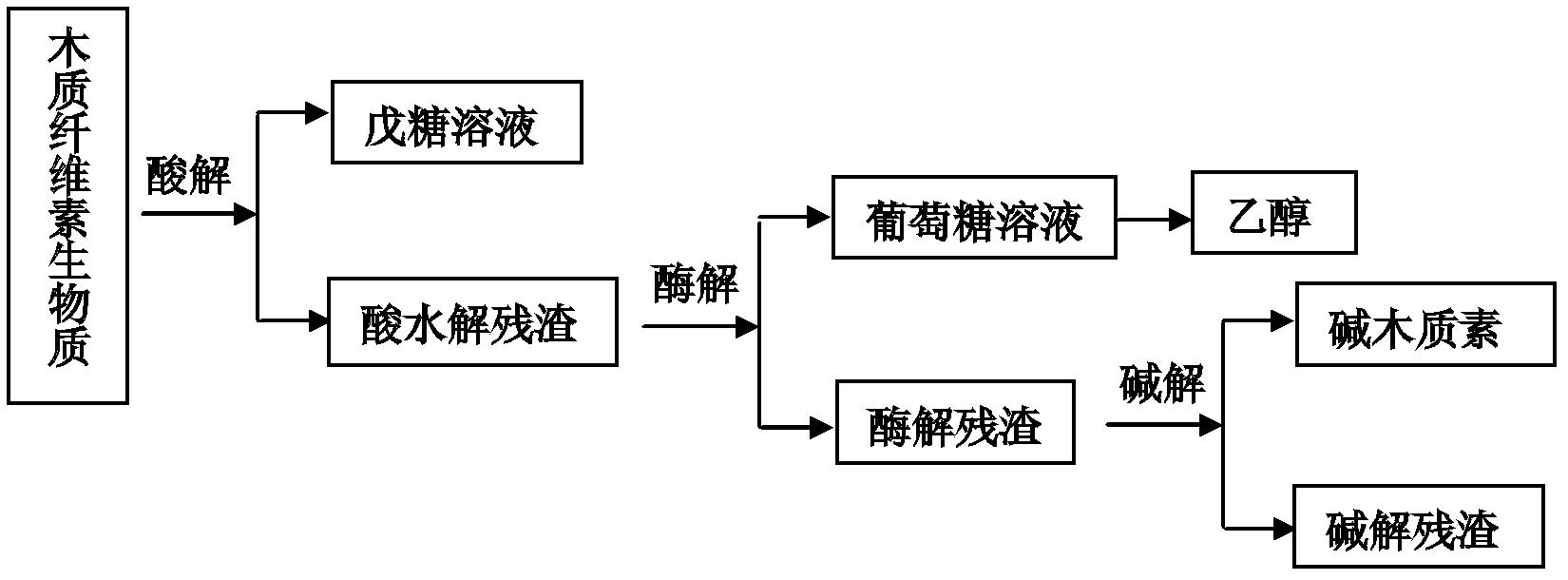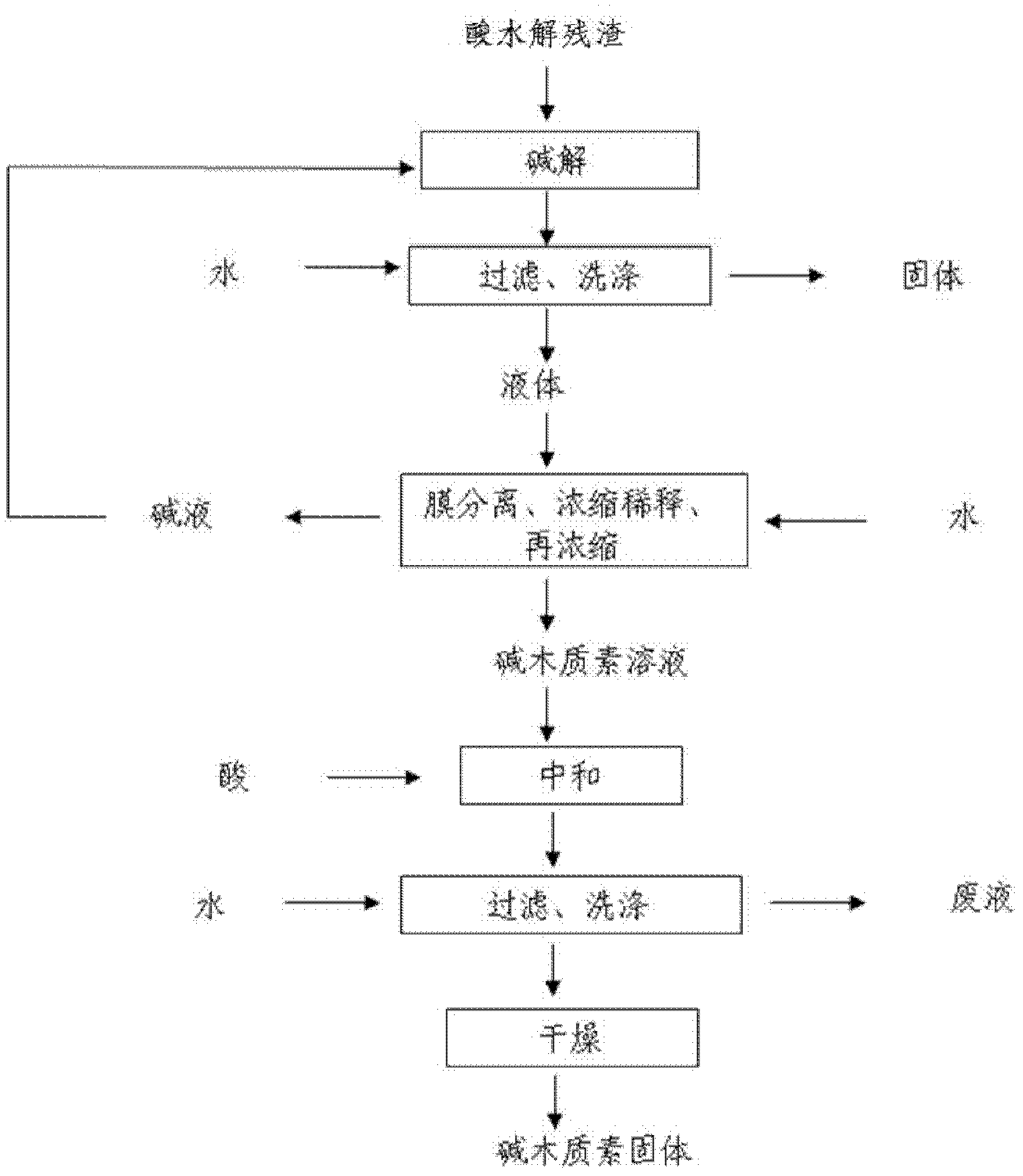Comprehensive utilization method of lignocellulose biomass
A lignocellulose and biomass technology, applied in the field of comprehensive utilization of cellulose, hemicellulose and lignin in lignocellulosic biomass, can solve the problem of not being able to obtain high activity, high hemicellulose and cellulose extraction rate at the same time and other problems to achieve the effect of shortening the running time, maintaining activity and reducing inhibition
- Summary
- Abstract
- Description
- Claims
- Application Information
AI Technical Summary
Problems solved by technology
Method used
Image
Examples
Embodiment 1
[0075] (1) N level hydrolysis
[0076] In the present embodiment: what adopt is tertiary acid hydrolysis, at first corn cob (mass component composition: moisture 6.12%, cellulose 35.19%, hemicellulose 32.1%, lignin 23.7%, other 2.95%) is smashed, Then add the newly prepared acid solution into the first-stage hydrolysis reactor, add the acid solution discharged from the first-stage acid hydrolysis reactor into the second-stage hydrolysis reactor, and add the acid solution discharged from the second-stage hydrolysis reactor into the third In the first-stage hydrolysis reaction kettle, the acid solution discharged from the third-stage reaction kettle is the final pentose solution, and the acid hydrolysis residue in the first-stage hydrolysis reaction kettle is taken out, and then new corn cob raw materials are put into it. The first-stage hydrolysis reactor is used as a new third-stage reactor, the original second-stage reactor is used as a new first-stage reactor, and the origin...
Embodiment 2
[0105] (1) N-level acid hydrolysis
[0106] Raw material and method are with embodiment 1 step (1), and difference is: the time of first-order hydrolysis reaction is 3 hours, and the time of second-order hydrolysis reaction is 2 hours, and the time of third-order hydrolysis reaction is 1 hour, every The temperature of grade acid hydrolysis is 110 ℃; The weight of acid hydrolysis residue obtained is 1.66×10 3 kg (the water content is about 65%, the absolute dry content of hemicellulose is 6.44%, the absolute dry content of cellulose is 52.9%, the absolute dry content of lignin is 35.27%), and the pentose sugar solution is 8.33×10 3 kg, the concentration of pentose sugar was 3.64%, and the extraction rate of hemicellulose was 89%.
[0107] (2) Enzymatic hydrolysis of cellulose
[0108] The conditions of the enzymolysis are: cellulase is commercially available cellulase (Heshibi Biotechnology Co., Ltd., 4w unit), and all the acid hydrolysis residues obtained in step (1) are tak...
Embodiment 3
[0118] (1) N-level acid hydrolysis
[0119] Raw material and method are with embodiment 1 step (1), and difference is that the time of first-order hydrolysis reaction is 1 hour, and the time of second-order hydrolysis reaction is 0.75 hour, and the time of third-order hydrolysis reaction is 0.5 hour, every The concentration of phosphoric acid hydrolyzed by grade acid is 15%; The weight of finally obtained acid hydrolysis residue is 1.80×10 3 kg (the water content is about 65%, the absolute dry content of hemicellulose is 10.27%, the absolute dry content of cellulose is 50.74%, and the absolute dry content of lignin is 34.01%), the pentose sugar solution is 8.20×10 3 kg, the concentration of pentose sugar was 3.37%, and the extraction rate of hemicellulose was 81%.
[0120] (2) Enzymatic hydrolysis of cellulose
[0121] Carry out enzymolysis to the above-mentioned acid hydrolysis residue, carry out cellulose enzymolysis according to the method for embodiment 1 step (2), diffe...
PUM
 Login to View More
Login to View More Abstract
Description
Claims
Application Information
 Login to View More
Login to View More - R&D
- Intellectual Property
- Life Sciences
- Materials
- Tech Scout
- Unparalleled Data Quality
- Higher Quality Content
- 60% Fewer Hallucinations
Browse by: Latest US Patents, China's latest patents, Technical Efficacy Thesaurus, Application Domain, Technology Topic, Popular Technical Reports.
© 2025 PatSnap. All rights reserved.Legal|Privacy policy|Modern Slavery Act Transparency Statement|Sitemap|About US| Contact US: help@patsnap.com



